Shopping For Outdoor Adventures, it is essential to find the right gear to enhance your experience. Whether you’re embarking on a thrilling hike or planning a camping trip with friends, having the appropriate outdoor gear will ensure your comfort, safety, and enjoyment. In this comprehensive guide, we will explore the top must-have items for outdoor adventures, offer tips on choosing the perfect gear, and provide valuable insights to enhance your shopping experience.
Key Takeaways: Shopping For Outdoor Adventures
- Choosing the right outdoor gear is crucial for a successful and enjoyable adventure.
- Consider factors such as durability, functionality, and personal preferences when shopping for gear.
- Investing in high-quality outdoor gear ensures comfort and preparedness during your outdoor activities.
- Research reviews and compare products to make informed decisions about your gear purchases.
- Take advantage of recommended apps and resources for hiking and camping enthusiasts.
What Should I Look for When Buying Outdoor, Hiking, and Camping Gear?
When shopping for outdoor, hiking, and camping gear, it’s important to consider several key factors. To ensure a successful outdoor adventure, prioritize durability, weight, and functionality in your gear choices. Look for high-quality gear made from lightweight materials that can withstand the demands of the great outdoors. Reviews can provide valuable insights into the performance and longevity of different products. By comparing various options and considering your specific needs and preferences, you can make informed decisions that align with your outdoor activities.
“The right gear can make all the difference in your outdoor experience. Prioritize durability, weight, and functionality when shopping for outdoor, hiking, and camping gear.”
Factors to Consider When Buying Outdoor, Hiking, and Camping Gear:
- Durability: Choose gear that can withstand rigorous outdoor use and last for multiple adventures.
- Weight: Opt for lightweight gear to minimize strain during hikes and trips.
- Functionality: Look for gear that fulfills specific needs, such as waterproof tents or moisture-wicking clothing.
Investing in high-quality outdoor gear will ultimately enhance your experience on the trail and at the campsite. Equipment that is durable, lightweight, and functional withstands the elements and ensures your comfort and safety throughout your outdoor excursions.
Comparison Table: Top Outdoor Gear Brands
| Brand | Specialty | Popular Products |
|---|---|---|
| Patagonia | Outdoor Apparel | Down Jackets, Fleece Pullovers |
| Osprey | Backpacks and Bags | Hiking Backpacks, Travel Bags |
| The North Face | Outdoor Apparel and Equipment | Tents, Fleece Jackets |
| Merrell | Hiking Shoes and Boots | Trail Running Shoes, Hiking Boots |
| Black Diamond | Climbing and Outdoor Equipment | Climbing Gear, Headlamps |
Note: The table above showcases a selection of popular outdoor gear brands across different specialties. These brands offer top-quality products that cater to various outdoor activities, including hiking, camping, and climbing.
What Are the Top 10 Must-Have Items for a Hiking Trip?
When embarking on a hiking trip, having the right gear is crucial for a successful and enjoyable adventure. Being well-prepared and equipped will ensure that you can tackle the challenges of the trail and fully immerse yourself in the beauty of nature. Here are the top 10 must-have items that every hiker should consider adding to their packing list:
- A Comfortable and Durable Backpack: A reliable backpack is essential for carrying all your gear. It should have padded shoulder straps and a supportive frame to distribute the weight efficiently. Look for a backpack with enough capacity for your needs, ensuring it is made from durable materials that can withstand the ruggedness of the trail.
- High-Quality Hiking Boots or Shoes: Investing in a pair of high-quality hiking boots or shoes is crucial for comfort and protection. They should provide excellent traction, ankle support, and be made from waterproof materials to keep your feet dry and secure on various terrains.
- A Hydration System: Staying hydrated is essential during a hike, especially in challenging conditions. A hydration system, such as a hydration bladder, allows you to easily access water and stay hydrated on the go, so you can focus on the trail without the hassle of stopping to drink from a water bottle.
- Navigation Tools: Carry reliable navigation tools such as a map, compass, and GPS device to ensure you can find your way on unfamiliar trails. These tools will provide peace of mind and help prevent you from getting lost.
- Weather-Appropriate Clothing: Dressing in layers and wearing weather-appropriate clothing is crucial for maintaining comfort and protection in different conditions. Pack moisture-wicking base layers, insulating mid-layers, a waterproof and windproof outer layer, and a hat and gloves to stay warm and dry.
- A First-Aid Kit: Accidents and injuries can happen on the trail, so it’s important to carry a well-stocked first-aid kit. Include items such as bandages, antiseptic wipes, pain relievers, blister treatment, and any necessary personal medications.
- A Multi-Tool or Knife: A versatile multi-tool or knife can come in handy for various tasks on the trail, such as cutting rope, opening cans, or repairing gear. Choose a compact and durable option that suits your needs.
- A Headlamp or Flashlight: Ensure you have a reliable source of light for nighttime hiking or emergencies. Headlamps or flashlights with long battery life and adjustable brightness are ideal for illuminating the path ahead.
- An Emergency Shelter: Pack a lightweight emergency shelter, such as a compact tent or a emergency bivvy, that can provide protection in unexpected situations, such as extreme weather or if you are stranded overnight.
- Nutritious Snacks and Meals: Fuels your body with nutritious, lightweight, and easily packable snacks and meals. Items such as trail mix, energy bars, dehydrated meals, and fruits can provide the necessary energy to keep you going during long hikes.
Investing in these must-have items will ensure that you are well-prepared and equipped for your hiking trip. Remember to personalize your gear selection based on the duration, terrain, and specific challenges of your adventure. Now that you’ve packed your essentials, it’s time to hit the trail and create unforgettable memories in the great outdoors!
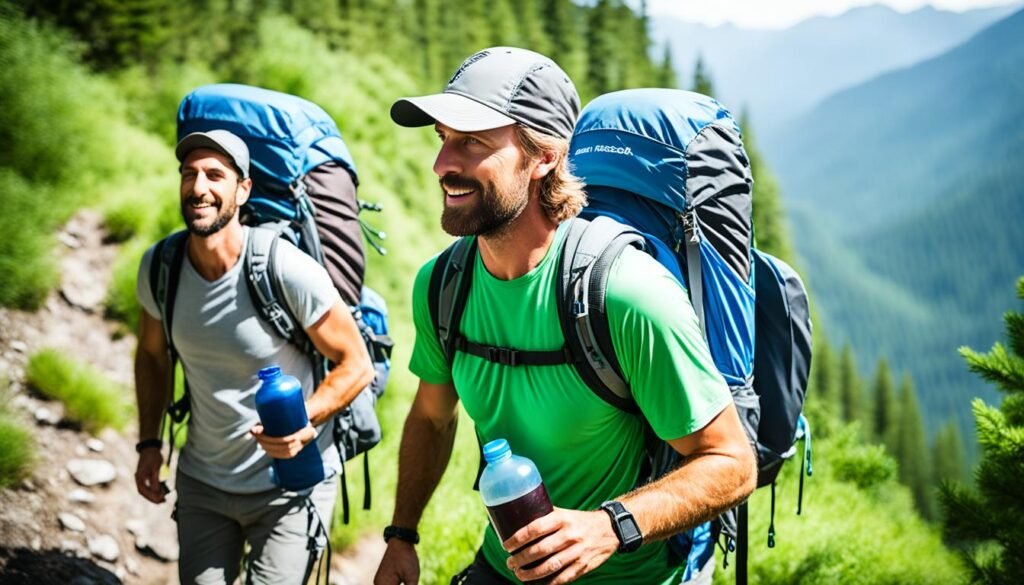
How Do I Choose the Perfect Hiking Backpack?
When embarking on a hiking adventure, choosing the right backpack is crucial for a comfortable and well-organized experience on the trail. A well-fitting hiking backpack not only carries your gear efficiently but also provides the necessary support and functionality. To select the perfect hiking backpack, consider the following factors:
- Capacity: Evaluate the capacity you need based on the duration and type of hiking trips you plan to undertake. Consider the size of your sleeping bag, tent, clothing, cooking equipment, and other essentials to ensure they can comfortably fit in your backpack.
- Fit and Comfort: Look for a backpack that offers adjustable hip belts, shoulder straps, and a torso length that matches your body size and shape. Optimal weight distribution is crucial to reduce strain on your back and shoulders during long hikes.
- Hydration Compatibility: Many hiking backpacks come with hydration reservoir compatibility, allowing you to easily access water on the move. This feature is essential for staying hydrated during your hikes.
- Organization Options: Consider the number and type of pockets, compartments, and attachment points available in the backpack. Adequate organization helps you keep your gear easily accessible and well-arranged.
- Rain Cover: Look for a backpack that includes a built-in or detachable rain cover to protect your gear in wet weather conditions. Keeping your belongings dry is crucial for a comfortable hike.
- Weight: Choose a backpack made of lightweight materials without compromising durability. Carrying unnecessary weight can be tiring and affect your overall hiking experience.
- Price: Set a budget and select a backpack that offers the best value for your money. Consider the features and durability of the backpack in relation to its price.
Comparison Table: Top Hiking Backpacks
Here is a comparison table of some popular hiking backpacks to help you choose the perfect one for your outdoor adventures:
| Backpack | Capacity | Fit and Comfort | Hydration Compatibility | Organization Options | Rain Cover | Weight (lbs) | Price |
|---|---|---|---|---|---|---|---|
| Brand A | 50L | Adjustable straps | Compatible | Multiple pockets and attachment points | Detachable rain cover | 3.5 | $150 |
| Brand B | 60L | Ergonomic design | Integrated hydration system | Various compartments | Built-in rain cover | 4.2 | $200 |
| Brand C | 40L | Adjustable hip belt and shoulder straps | Not compatible | Minimalist design with essentials organization | No rain cover | 2.9 | $120 |
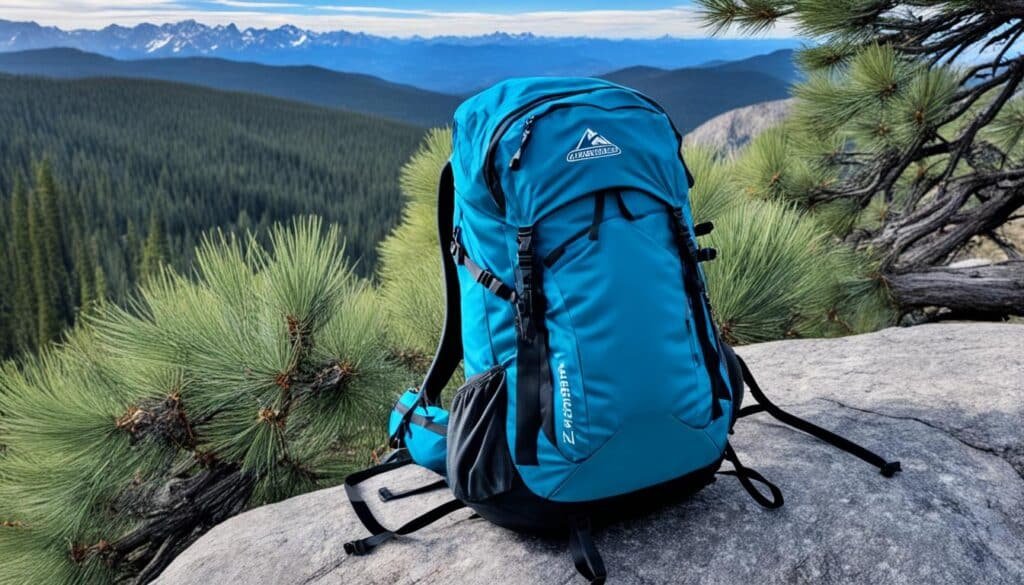
Remember, choosing the perfect hiking backpack involves finding the right balance between capacity, fit, comfort, features, and price. Take the time to research and try on different backpacks to ensure the one you choose meets your specific needs and preferences. A well-chosen hiking backpack will be your trusted companion on countless outdoor adventures.
What’s the Best Way to Break in New Hiking Boots?
Breaking in new hiking boots is crucial for preventing blisters and ensuring a comfortable fit. Taking the time to properly break in your boots will make your hiking experience much more enjoyable. Here are some steps to help you break in your new hiking boots:
- Start by wearing your new boots indoors for a few hours to allow your feet to adjust to the fit and break in the boots gradually.
- Gradually increase the duration and difficulty of your walks wearing the boots. Start with shorter walks on flat surfaces and then progress to longer hikes with more challenging terrain.
- Pay attention to any hotspots or blisters that may develop as you wear the boots. Address these issues by adjusting the lacing techniques or using moleskin or blister bandages to provide relief and prevent further discomfort.
- Consider using a waterproofing treatment on your boots to enhance their durability and protect them from moisture during your hikes.
Remember, breaking in new hiking boots requires patience and perseverance. It’s worth the effort to ensure a comfortable and enjoyable hiking experience.
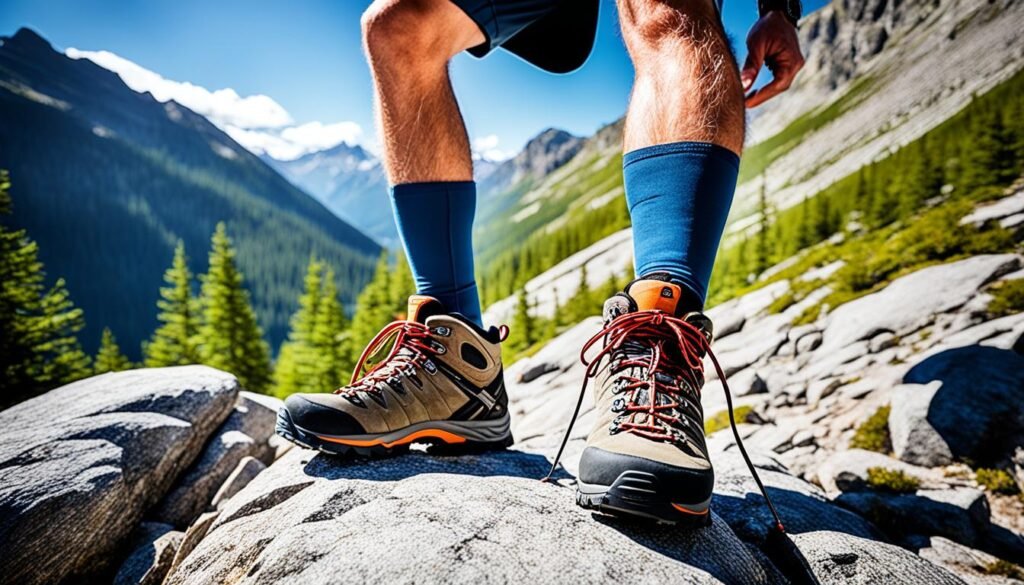
What Types of Clothing Should I Wear for Hiking and Camping?
When embarking on a hiking or camping adventure, choosing the right clothing is essential for comfort, protection, and performance. The type of clothing you wear depends on factors such as temperature, terrain, and the duration of your hike. Here are some essential clothing items to consider:
Moisture-Wicking Pants
Opt for comfortable moisture-wicking pants made from breathable materials. These pants help regulate body temperature, keep you dry, and prevent chafing during long hikes. Look for options specifically designed for outdoor activities to ensure durability and flexibility.
Moisture-Wicking Top
Avoid cotton tops as they tend to retain moisture and can make you feel uncomfortable. Instead, choose moisture-wicking tops made from synthetic materials such as polyester or merino wool. These tops will keep you dry by wicking away sweat and regulating your body temperature.
Warm Jacket
Even during warmer months, temperatures can drop unexpectedly, especially at higher altitudes. Pack a warm jacket or fleece layer to keep you warm during chilly evenings or in colder climates. Look for jackets that are lightweight, packable, and provide insulation without compromising mobility.
Rain Jacket
Weather conditions can change quickly during outdoor adventures. It’s important to have a reliable rain jacket to protect you from unexpected rain showers and keep you dry. Look for waterproof and breathable options with adjustable hoods and sealed seams to ensure maximum protection.
Brimmed Hat
A brimmed hat is essential for shielding your face and neck from the sun’s harmful UV rays. Choose a hat with a wide brim that provides shade and helps keep you cool. Look for hats made from lightweight and quick-drying materials for added comfort.
Sturdy Shoes
Invest in a pair of sturdy and supportive hiking boots or shoes that are designed for the terrain you’ll be exploring. Look for footwear with good traction, ankle support, and waterproof features. Consider the length and difficulty of your hike when choosing the appropriate footwear.
By selecting the right clothing for your hiking and camping adventures, you’ll ensure comfort, protection, and optimal performance on the trail. Remember to pack layers that can be easily adjusted based on the weather conditions. Don’t forget to check the weather forecast and pack accordingly. With the right clothing, you’ll be ready to conquer any outdoor challenge!
How Can I Stay Hydrated During a Hike?
Staying hydrated during a hike is crucial for your health and comfort. Proper hydration helps maintain energy levels, body temperature, and overall well-being. Here are some essential tips to help you stay hydrated on the trail:
1. Pack Sufficient Water
When going on a hike, it’s important to carry an adequate amount of water to meet your hydration needs. Pack a water bottle or hydration reservoir that suits your capacity requirements. Consider the duration, intensity, and weather conditions of your hike to determine how much water you’ll need.
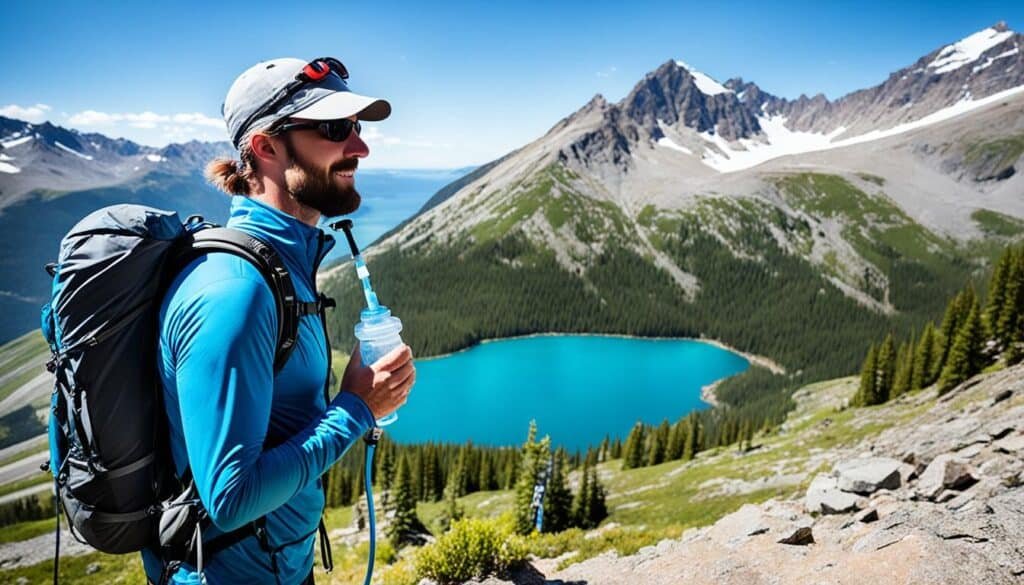
2. Opt for Hydration Systems
Using hydration systems, such as hydration reservoirs with a drinking tube, can provide convenience during your hike. These systems allow you to drink water without having to remove your backpack, allowing you to stay hydrated on the move. Ensure your hydration system is easily accessible and properly maintained.
3. Drink Regularly
During your hike, make it a habit to drink water regularly, even if you don’t feel thirsty. Thirst is not always an accurate indicator of hydration levels. Take small sips of water at frequent intervals to maintain hydration throughout your hike.
4. Consider Electrolyte Supplements
Electrolyte supplements can be particularly beneficial during longer and more strenuous hikes. These supplements help replenish essential minerals lost through sweating and can aid in maintaining electrolyte balance. Consult with a healthcare professional or nutritionist to choose the most suitable electrolyte supplement for your needs.
“Proper hydration during a hike is vital for your health and performance on the trail. Pack enough water, consider hydration systems, drink regularly, and consider electrolyte supplements if necessary”
5. Monitor Urine Color
Monitoring the color of your urine throughout the hike can provide insight into your hydration status. Clear to pale yellow urine indicates proper hydration, while darker urine may indicate dehydration. Aim to maintain a light yellow color throughout your hike.
6. Take Advantage of Natural Water Sources
If there are natural water sources along your hiking route, such as rivers, streams, or springs, take advantage of them. Carry a water purification method, such as a water filter or purification tablets, to ensure the water is safe to drink. Refilling your water supply from natural sources can help conserve the water you carry.
7. Plan Water Breaks
When planning your hike, make sure to factor in designated water breaks. Choose scenic spots with access to water sources where you can rest, refill your water supply, and take a moment to rehydrate. Planning these breaks helps ensure you prioritize hydration throughout your hike.
By taking these steps to stay hydrated during your hike, you can maintain optimal performance, prevent dehydration, and enhance your overall outdoor experience.
How Do I Choose the Right Tent for My Camping Adventure?
When planning a camping adventure, choosing the right tent is essential to ensure a comfortable and enjoyable experience. Several factors should be considered when making this decision, including:
- Capacity: Assess how many people will be using the tent and select a size that accommodates everyone comfortably. Consider the need for additional space for gear as well.
- Weight: If you plan on backpacking or hiking to your campsite, opt for a lightweight tent that won’t add unnecessary bulk to your pack.
- Durability: Look for a tent made from high-quality materials that can withstand varying weather conditions and offer long-lasting performance.
- Weather Resistance: Take into account the typical weather conditions of the areas you’ll be camping in and choose a tent that provides adequate protection from rain, wind, and other elements.
- Ease of Setup: Consider the ease and speed of setting up the tent. Look for features like color-coded poles and clear setup instructions to simplify the process.
Whether you’re backpacking solo or embarking on a family camping trip, there are different types of tents to suit your specific needs:
Backpacking Tents: Designed with lightweight materials and a compact design, backpacking tents are perfect for those who prioritize portability and easy setup. They are generally suitable for one to three people and are ideal for hikers and backpackers who plan to cover long distances.
Family Tents: If you’re camping with a larger group or prefer spacious accommodations, family tents offer generous headroom and ample space to comfortably sleep multiple people. These tents often feature separate rooms or dividers, providing privacy and organization.
Remember to consider your camping needs and preferences when choosing the right tent. Investing in a high-quality tent that fits your requirements will ensure a cozy and protected camping experience.
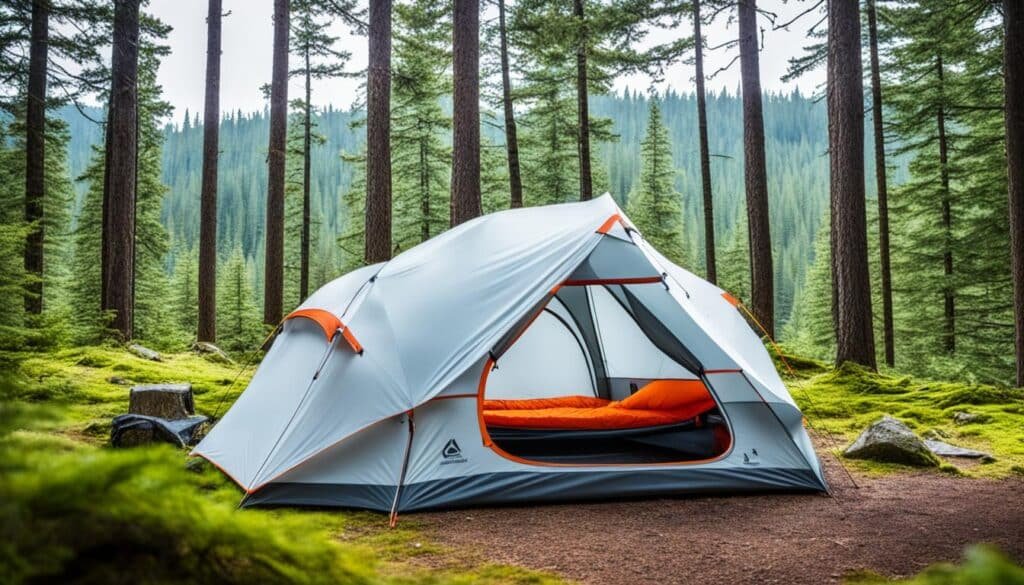
What Camping Cookware and Utensils Should I Bring?
When preparing for a camping trip, it’s essential to pack the right camping cookware and utensils to ensure a successful outdoor cooking experience. Lightweight and durable options are ideal for camping, as they are easy to carry and can withstand the rigors of outdoor use. Consider the number of people you will be cooking for and the types of meals you plan to prepare when selecting your cookware and utensils.
One of the most important items to bring is a camping stove. This portable cooking device allows you to cook meals easily and efficiently in the great outdoors. Choose a camping stove that suits your needs, whether it’s a compact backpacking stove or a larger, more powerful stove for group cooking.
Along with a camping stove, you’ll need fuel to power it. Make sure to pack enough fuel for the duration of your camping trip. It’s always a good idea to bring extra fuel, just in case.
When it comes to cookware, a lightweight and nonstick pot or pan is essential. Look for one with a durable construction that can handle high heat. A collapsible or nesting cookware set is a great option, as it takes up minimal space in your camping gear.
In terms of utensils, a basic set including a spatula, tongs, and a spoon is usually sufficient. Opt for utensils made of stainless steel or other sturdy materials that won’t easily bend or break. Consider bringing a multitool with a built-in knife for added convenience.
Don’t forget to pack plates or bowls for serving your meals. Look for compact and lightweight options that are easy to clean. Stainless steel or durable plastic plates and bowls are popular choices for camping.
To summarize, here’s a list of essential camping cookware and utensils to bring:
- Camping stove
- Fuel for the stove
- Nonstick pot or pan
- Utensils (spatula, tongs, spoon)
- Multitool with a knife
- Plates or bowls
With these essential items, you’ll be well-equipped to cook delicious meals while enjoying your camping adventure. Remember to pack lightweight and durable options that will make outdoor cooking a breeze!
How Do I Choose the Right Sleeping Bag for My Camping Trip?
When planning a camping trip, one of the essential items to consider is the sleeping bag. Choosing the right sleeping bag is crucial for a comfortable and restful night’s sleep under the stars. Several factors should be taken into account to make an informed decision that meets your specific needs and preferences.
Temperature Rating
The temperature rating of a sleeping bag indicates the lowest temperature at which it can keep you warm. It is important to select a sleeping bag with a temperature rating suitable for the expected weather conditions during your camping trip. If you’re unsure, it’s generally a good idea to choose a sleeping bag with a lower temperature rating to ensure you stay warm even in unexpected chilly nights.
Insulation Type
There are two main types of insulation used in sleeping bags: down and synthetic. Down insulation offers excellent warmth-to-weight ratio and is highly compressible, making it ideal for backpacking trips. Synthetic insulation, on the other hand, performs better in wet conditions as it retains its insulating properties even when damp. Consider the climate and the level of moisture you may encounter during your camping trip to determine the most suitable insulation type for your sleeping bag.
Size and Shape
Sleeping bags come in various sizes and shapes, including rectangular, mummy, and semi-rectangular. Rectangular sleeping bags provide more space for movement and are often preferred for comfort during car camping. Mummy-shaped sleeping bags, on the other hand, offer a snug fit that minimizes empty air space, providing better insulation and warmth. Consider your preference for freedom of movement versus warmth and insulation when choosing the size and shape of your sleeping bag.
Weight and Packability
If you plan to backpack or hike to your camping destination, the weight and packability of your sleeping bag become crucial factors. Lightweight sleeping bags are designed to minimize the overall weight of your backpack, allowing for easier transport. Look for sleeping bags made with lightweight materials and those that compress well into a compact size, making them easier to carry during your outdoor adventures.
Other factors to consider when choosing a sleeping bag include the zipper quality and location, hood design for added warmth around the head and neck, and overall durability and quality of construction. It’s also worth considering special features such as draft tubes, draft collars, or built-in pillows for added comfort.
By considering the temperature rating, insulation type, size and shape, weight and packability, and additional considerations, you can choose the right sleeping bag that will provide a cozy and comfortable sleep during your camping adventure.
What Are the Best Food Options for Hiking and Camping?
When it comes to food options for hiking and camping, it is important to prioritize nutrition, weight, and packability. Choosing the right food can fuel your adventures and keep you energized throughout your outdoor excursions. Here are some top food recommendations for hiking and camping:
1. Freeze-Dried Meals
Freeze-dried meals are lightweight, easy to prepare, and packed with nutrients. These meals come in a variety of flavors and options, including breakfast, lunch, and dinner. Simply add hot water to rehydrate the meal, and you’ll have a delicious and satisfying dish ready in minutes.
2. Trail Mix
Trail mix is a versatile and convenient snack for hiking and camping. It typically consists of a mixture of nuts, dried fruits, and other tasty additions like chocolate or granola. This snack provides a good balance of protein, healthy fats, and carbohydrates to keep you fueled and satisfied on the trail.
3. Energy Bars
Energy bars are compact, lightweight, and easy to carry, making them an ideal choice for outdoor adventures. Look for bars that are high in protein and low in added sugars. These bars provide a quick and convenient source of energy, perfect for a mid-hike pick-me-up.
4. Dehydrated Fruits and Vegetables
Dehydrated fruits and vegetables are lightweight, non-perishable, and retain most of their nutritional value. They make a great addition to trail mix, can be rehydrated to create side dishes or added to meals, and provide a natural sweetness and boost of nutrients.
Also Read:- Top 10 Best Shopping Apps for Deals & Savings
Remember to consider any dietary restrictions or preferences when selecting food for your outdoor adventures. Whether you’re hiking through rugged terrain or camping under the stars, these food options will keep you nourished and ready for your next outdoor challenge.
Conclusion
Shopping for outdoor adventures can be an exciting and enjoyable experience, especially when armed with the right knowledge and guidance. By considering factors such as durability, functionality, and personal preferences, you can choose outdoor gear that will enhance your outdoor adventures. Whether you’re embarking on a challenging mountain hike or a relaxing camping trip, investing in high-quality gear ensures that you’re well-prepared and comfortable throughout your journey.
When shopping for outdoor gear, remember to prioritize safety, comfort, and the specific needs of your outdoor activities. Whether it’s a sturdy backpack, durable hiking boots, or weather-resistant clothing, each piece of gear plays a crucial role in your overall experience. Researching and comparing different options, reading user reviews, and consulting with outdoor experts can help you make informed decisions.
So, get ready to embark on your next outdoor adventure with confidence! Explore reputable outdoor gear brands such as The North Face, REI Co-op, Patagonia, Columbia, and Arc’teryx for an extensive range of quality options. From hiking and camping equipment to clothing and accessories, these brands offer a variety of products to suit every adventurer’s needs. Happy shopping and may your outdoor adventures be filled with memorable moments!
FAQs
A: When preparing for your next adventure, it’s essential to consider items such as a backpack, hiking boots, water bottle, navigation tools, appropriate clothing, and first aid kit.
Q: Where can I shop for top outdoor brands like Patagonia and REI?
A: You can shop for outdoor brands like Patagonia and REI at specialty retailers or their official websites.
Q: What should I look for when comparing products for outdoor activities like kayaking?
A: When comparing products for kayaking, consider factors like durability, comfort, weight, and specific features such as storage compartments or adjustable straps.
Q: Is it important to have a comprehensive gear list for a hiking adventure?
A: Yes, having a comprehensive gear list for a hiking adventure is crucial to ensure you have all the necessary items for safety and comfort in the wilderness.
Q: Where can I find used gear for outdoor activities like skiing or snowboarding?
A: You can find used gear for activities like skiing or snowboarding at specialty shops, online marketplaces, or through gear rental services.
Q: What are some outdoor retailers that offer a great selection of gear and clothing?
A: Some outdoor retailers known for their excellent selection of gear and clothing include REI, Patagonia, and other premium brands that cater to outdoor enthusiasts.
Q: What type of gear should I consider for rock climbing adventures?
A: For rock climbing adventures, it’s important to have gear such as a harness, climbing shoes, ropes, carabiners, and a helmet for safety and performance.
Conclusion
Shopping for outdoor adventures can be an exciting and enjoyable experience when you have the right knowledge and guidance. By considering factors such as durability, functionality, and personal preferences, you can choose gear that will enhance your outdoor adventures. Investing in high-quality outdoor gear ensures that you are well-prepared and comfortable during your hikes and camping trips. Remember to prioritize safety, comfort, and the specific needs of your outdoor activities when making your gear selection. Happy shopping and happy adventuring!





